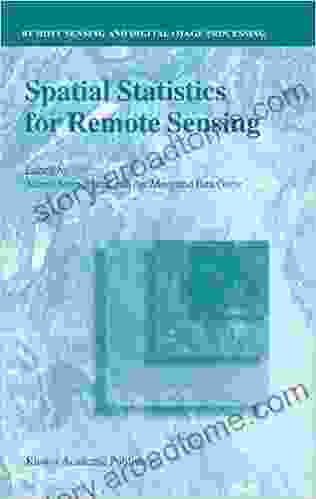Spatial Statistics for Remote Sensing: Unleashing the Power of Geographic Data in Image Analysis

In the rapidly evolving world of remote sensing and digital image analysis, spatial statistics has emerged as an indispensable tool. By incorporating geographic information into statistical models, spatial statistics empowers researchers and analysts to uncover hidden patterns, quantify spatial relationships, and make informed decisions based on geospatial data. This article delves into the fascinating world of spatial statistics for remote sensing, exploring its principles, applications, and the transformative impact it has on image analysis.
Understanding Spatial Statistics
Spatial statistics revolves around the idea that geographic data exhibits spatial autocorrelation, meaning that values at nearby locations tend to be more similar than those at distant locations. This spatial dependency violates the assumption of independence in traditional statistical methods, leading to biased and unreliable results.
5 out of 5
| Language | : | English |
| File size | : | 4894 KB |
| Text-to-Speech | : | Enabled |
| Print length | : | 325 pages |
Spatial statistics addresses this challenge by explicitly incorporating the spatial relationships between data points into the analysis. By accounting for spatial autocorrelation, spatial statistics provides more accurate and meaningful insights from geospatial data, enabling researchers to draw robust s and develop effective strategies based on their findings.
Key Concepts in Spatial Statistics for Remote Sensing
* Spatial Autocorrelation: The tendency for nearby geographic data points to have similar values. * Geostatistics: A branch of spatial statistics that focuses on analyzing and modeling spatially correlated data. * Point Patterns: Statistical methods for analyzing the distribution and patterns of points in space. * Spatial Regression: A type of statistical modeling that incorporates spatial relationships into regression models to improve prediction and estimation accuracy. * Geospatial Interpolation: Techniques for predicting values at unsampled locations based on known values at nearby locations.
Applications of Spatial Statistics in Remote Sensing
The applications of spatial statistics in remote sensing are vast and encompass a wide range of disciplines, including:
* Environmental Monitoring: Identifying and assessing spatial patterns in environmental variables, such as land cover, water quality, and air pollution. * Resource Exploration: Analyzing spatial relationships between geological features and natural resources to optimize exploration strategies. * Land Use Planning: Evaluating the spatial distribution and changes in land use patterns to support sustainable development and urban planning. * Precision Agriculture: Utilizing spatial analysis techniques to optimize crop yields, manage soil health, and predict agricultural risks. * Public Health: Studying the spatial distribution of diseases and identifying risk factors to develop targeted prevention and intervention strategies.
Benefits of Using Spatial Statistics in Remote Sensing
* Improved Data Analysis: Spatial statistics provides more accurate and reliable results by accounting for spatial autocorrelation. * Enhanced Decision-Making: By uncovering hidden patterns and quantifying spatial relationships, spatial statistics supports better decision-making based on geospatial data. * Increased Efficiency: Geospatial interpolation techniques enable efficient prediction of values at unsampled locations, saving time and resources. * Novel Insights: Spatial analysis reveals intricate relationships between geographic variables, leading to the discovery of new patterns and insights. * Broad Applicability: Spatial statistics is applicable to a wide range of fields, making it a versatile tool for researchers and analysts.
Spatial statistics is a powerful tool that enhances the analysis and utilization of geospatial data in remote sensing and digital image analysis. By incorporating geographic information into statistical models, spatial statistics uncovers hidden patterns, quantifies spatial relationships, and enables data-driven decision-making. With its broad applicability and transformative impact, spatial statistics empowers researchers, analysts, and decision-makers to gain deeper insights from geospatial data and address complex challenges in various fields.
Embrace the power of spatial statistics for remote sensing and embark on a journey of discovery, unlocking the secrets hidden within geospatial data. Let spatial statistics guide your analysis, inform your decisions, and empower your research with unparalleled accuracy, efficiency, and innovation.
5 out of 5
| Language | : | English |
| File size | : | 4894 KB |
| Text-to-Speech | : | Enabled |
| Print length | : | 325 pages |
Do you want to contribute by writing guest posts on this blog?
Please contact us and send us a resume of previous articles that you have written.
 Book
Book Novel
Novel Page
Page Chapter
Chapter Text
Text Story
Story Genre
Genre Reader
Reader Library
Library Paperback
Paperback E-book
E-book Magazine
Magazine Newspaper
Newspaper Paragraph
Paragraph Sentence
Sentence Bookmark
Bookmark Shelf
Shelf Glossary
Glossary Bibliography
Bibliography Foreword
Foreword Preface
Preface Synopsis
Synopsis Annotation
Annotation Footnote
Footnote Manuscript
Manuscript Scroll
Scroll Codex
Codex Tome
Tome Bestseller
Bestseller Classics
Classics Library card
Library card Narrative
Narrative Biography
Biography Autobiography
Autobiography Memoir
Memoir Reference
Reference Encyclopedia
Encyclopedia Lisa Lockwood
Lisa Lockwood Leslie Parker
Leslie Parker Lee Carroll
Lee Carroll Berrino Franco
Berrino Franco Sherry Gaba
Sherry Gaba Layla Moon
Layla Moon Livio Presutti
Livio Presutti Manuel Gausa
Manuel Gausa Lori Wick
Lori Wick Patricia Vicary
Patricia Vicary Matthew Mindrup
Matthew Mindrup Lionel Friedberg
Lionel Friedberg Leigh Robinson
Leigh Robinson Octavia F Raheem
Octavia F Raheem Peter Harmsen
Peter Harmsen Norman Hewitt
Norman Hewitt Woojong Kim
Woojong Kim R S Rodella
R S Rodella Wilburta Q Lindh
Wilburta Q Lindh Lisa Dillman
Lisa Dillman
Light bulbAdvertise smarter! Our strategic ad space ensures maximum exposure. Reserve your spot today!

 E.E. CummingsThe Best Cornmeal Cookbook Ever: For Beginners, Mini Cakes, Italian Cookies,...
E.E. CummingsThe Best Cornmeal Cookbook Ever: For Beginners, Mini Cakes, Italian Cookies,...
 Miguel de CervantesMaster the Art of Peyote Stitch: Unleash Your Creativity with 15 Inspiring...
Miguel de CervantesMaster the Art of Peyote Stitch: Unleash Your Creativity with 15 Inspiring... Juan RulfoFollow ·18.5k
Juan RulfoFollow ·18.5k Emmett MitchellFollow ·17.4k
Emmett MitchellFollow ·17.4k Arthur MasonFollow ·10.3k
Arthur MasonFollow ·10.3k Ezekiel CoxFollow ·6k
Ezekiel CoxFollow ·6k Robert HeinleinFollow ·18.4k
Robert HeinleinFollow ·18.4k Rudyard KiplingFollow ·13.9k
Rudyard KiplingFollow ·13.9k Earl WilliamsFollow ·2.3k
Earl WilliamsFollow ·2.3k Guy PowellFollow ·7.5k
Guy PowellFollow ·7.5k

 E.M. Forster
E.M. ForsterThe Real Blueprint to Short-Term Rental Success
Are you ready to create a...

 Mark Mitchell
Mark MitchellMidas Touch: The Astrology Of Wealth
Are you ready to tap into the cosmic forces...

 Grant Hayes
Grant HayesPrecarious Creativity: Unpacking the Global Media and...
In the ever-evolving landscape of the...

 Cameron Reed
Cameron ReedGuru Govind Singh: A Life of Courage and Inspiration for...
Guru Govind Singh, the tenth Sikh guru,...

 Yukio Mishima
Yukio MishimaCastles & Shapes: The Enchanting World of Ris...
In the realm of...

 Jerome Blair
Jerome BlairGolden Keys To Jyotisha Volume Ten: The Ultimate Guide to...
Embark on an...
5 out of 5
| Language | : | English |
| File size | : | 4894 KB |
| Text-to-Speech | : | Enabled |
| Print length | : | 325 pages |








